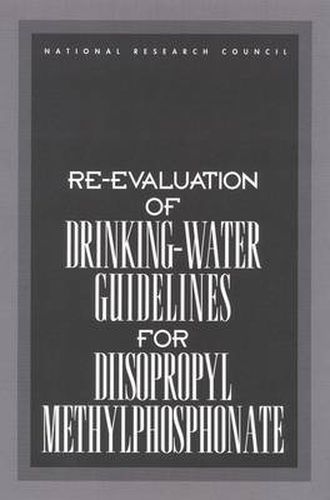Readings Newsletter
Become a Readings Member to make your shopping experience even easier.
Sign in or sign up for free!
You’re not far away from qualifying for FREE standard shipping within Australia
You’ve qualified for FREE standard shipping within Australia
The cart is loading…






Diisopropyl Methylphosphonate (DIMP) is a groundwater contaminant at the U.S. Army’s Rocky Mountain Arsenal in Colorado. DIMP is a by-product created from the manufacture and detoxification of the nerve agent GB which the arsenal produced from 1953 to 1957. For awhile the Army and the State of Colorado disagreed upon the appropriate drinking-water contaminant guideline for DIMP. A drinking-water guideline of 600 micrograms per liter was established by the U.S. Environmental Protection Agency (EPA) in 1989 but the State of Colorado promulgated a lower guideline of 8 micrograms per liter. The significant difference between the two suggested values arose from the fact that both sides used different studies to determine their values. Colorado used one-generation reproductive toxicity study in mink, whereas EPA used a subchronic toxicity study in dogs.
To resolve the disagreement, a two-generation reproductive study in mink was conducted. The Army asked the National Research Council (NRC) to independently evaluate the 1997 study and re-evaluate the drinking-water guideline for DIMP. This task was assigned to the Committee on Toxicology, which established the Subcommittee on the Toxicity of Diisopropyl Methylphosphonate, a multidisciplinary group of experts. The subcommittee evaluated the two-generation reproductive study as well as other studies relevant to the task. Data on the use of mink as a predictive model in toxicology were also reviewed. Re-Evaluation of Drinking-Water Guidelines for Diisopropyl Methylphosphonate is the subcommittee’s report which shows that neither party was corrected in their DIMP guidelines. The report includes the subcommittee’s evaluation and recommendations concerning the topic.
$9.00 standard shipping within Australia
FREE standard shipping within Australia for orders over $100.00
Express & International shipping calculated at checkout
Diisopropyl Methylphosphonate (DIMP) is a groundwater contaminant at the U.S. Army’s Rocky Mountain Arsenal in Colorado. DIMP is a by-product created from the manufacture and detoxification of the nerve agent GB which the arsenal produced from 1953 to 1957. For awhile the Army and the State of Colorado disagreed upon the appropriate drinking-water contaminant guideline for DIMP. A drinking-water guideline of 600 micrograms per liter was established by the U.S. Environmental Protection Agency (EPA) in 1989 but the State of Colorado promulgated a lower guideline of 8 micrograms per liter. The significant difference between the two suggested values arose from the fact that both sides used different studies to determine their values. Colorado used one-generation reproductive toxicity study in mink, whereas EPA used a subchronic toxicity study in dogs.
To resolve the disagreement, a two-generation reproductive study in mink was conducted. The Army asked the National Research Council (NRC) to independently evaluate the 1997 study and re-evaluate the drinking-water guideline for DIMP. This task was assigned to the Committee on Toxicology, which established the Subcommittee on the Toxicity of Diisopropyl Methylphosphonate, a multidisciplinary group of experts. The subcommittee evaluated the two-generation reproductive study as well as other studies relevant to the task. Data on the use of mink as a predictive model in toxicology were also reviewed. Re-Evaluation of Drinking-Water Guidelines for Diisopropyl Methylphosphonate is the subcommittee’s report which shows that neither party was corrected in their DIMP guidelines. The report includes the subcommittee’s evaluation and recommendations concerning the topic.